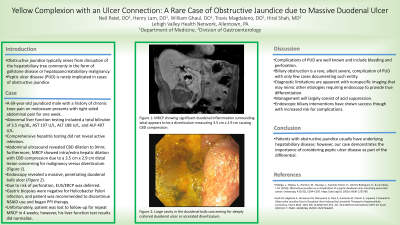Monday Poster Session
Category: Biliary/Pancreas
P1560 - Yellow Complexion With an Ulcer Connection: A Rare Case of Obstructive Jaundice Due to Massive Duodenal Ulcer
Monday, October 23, 2023
10:30 AM - 4:15 PM PT
Location: Exhibit Hall

Has Audio
.jpg)
Neil Patel, DO
Lehigh Valley Health Network
Allentown, PA
Presenting Author(s)
Neil Patel, DO, Henry Lam, DO, William Ghaul, DO, Travis Magdaleno, DO, Hiral Shah, MD
Lehigh Valley Health Network, Allentown, PA
Introduction: Obstructive jaundice typically arises due to disruption of the hepatobiliary tree. Commonly, this is seen from biliary stone disease or hepatobiliary malignancy. Peptic ulcer disease (PUD) is rarely implicated in these cases. Here, we highlight an atypical presentation of obstructive jaundice due to a deep cratered duodenal bulb ulcer.
Case Description/Methods: A 69-year-old male with a history of chronic knee pain on meloxicam presented with right sided abdominal pain ongoing for one week. Exam revealed a jaundiced appearance with generalized tenderness to palpation of the abdomen. Labs were significant for abnormal liver function tests, including total bilirubin 3.5 mg/dL, AST 197 U/L, ALT 188 U/L, ALP 497 U/L. Lipase and INR were normal. Comprehensive hepatitis profile was negative for active infection. RUQ ultrasound revealed a 9 mm dilation of the common bile duct. Subsequent MRCP showed intrahepatic and extrahepatic dilation due to distal obstruction caused by a 3.5 x 2.9 cm lesion concerning for malignancy. EGD/EUS, interestingly, revealed a massive penetrating duodenal bulb ulcer. ERCP was not performed at the time due to risk of perforation. Patient was started on twice daily pantoprazole and advised to avoid NSAIDs. His symptoms improved, and he was instructed to follow up with gastroenterology as an outpatient.
Discussion: Complications of PUD are well-known and include gastric outlet obstruction. However, biliary tree obstruction is a severe complication with only a handful of case reports documenting such entity. Diagnostic limitations are apparent with nonspecific imaging that may mimic other etiologies requiring endoscopy to provide true differentiation. Management will largely consist of acid suppression. Endoscopic biliary interventions have shown success, albeit with increased risk for further complications. Obstructive jaundice usually manifests from underlying hepatobiliary disease. However, our case demonstrates the importance of considering peptic ulcer disease as part of the differential.
Disclosures:
Neil Patel, DO, Henry Lam, DO, William Ghaul, DO, Travis Magdaleno, DO, Hiral Shah, MD. P1560 - Yellow Complexion With an Ulcer Connection: A Rare Case of Obstructive Jaundice Due to Massive Duodenal Ulcer, ACG 2023 Annual Scientific Meeting Abstracts. Vancouver, BC, Canada: American College of Gastroenterology.
Lehigh Valley Health Network, Allentown, PA
Introduction: Obstructive jaundice typically arises due to disruption of the hepatobiliary tree. Commonly, this is seen from biliary stone disease or hepatobiliary malignancy. Peptic ulcer disease (PUD) is rarely implicated in these cases. Here, we highlight an atypical presentation of obstructive jaundice due to a deep cratered duodenal bulb ulcer.
Case Description/Methods: A 69-year-old male with a history of chronic knee pain on meloxicam presented with right sided abdominal pain ongoing for one week. Exam revealed a jaundiced appearance with generalized tenderness to palpation of the abdomen. Labs were significant for abnormal liver function tests, including total bilirubin 3.5 mg/dL, AST 197 U/L, ALT 188 U/L, ALP 497 U/L. Lipase and INR were normal. Comprehensive hepatitis profile was negative for active infection. RUQ ultrasound revealed a 9 mm dilation of the common bile duct. Subsequent MRCP showed intrahepatic and extrahepatic dilation due to distal obstruction caused by a 3.5 x 2.9 cm lesion concerning for malignancy. EGD/EUS, interestingly, revealed a massive penetrating duodenal bulb ulcer. ERCP was not performed at the time due to risk of perforation. Patient was started on twice daily pantoprazole and advised to avoid NSAIDs. His symptoms improved, and he was instructed to follow up with gastroenterology as an outpatient.
Discussion: Complications of PUD are well-known and include gastric outlet obstruction. However, biliary tree obstruction is a severe complication with only a handful of case reports documenting such entity. Diagnostic limitations are apparent with nonspecific imaging that may mimic other etiologies requiring endoscopy to provide true differentiation. Management will largely consist of acid suppression. Endoscopic biliary interventions have shown success, albeit with increased risk for further complications. Obstructive jaundice usually manifests from underlying hepatobiliary disease. However, our case demonstrates the importance of considering peptic ulcer disease as part of the differential.
Disclosures:
Neil Patel indicated no relevant financial relationships.
Henry Lam indicated no relevant financial relationships.
William Ghaul indicated no relevant financial relationships.
Travis Magdaleno indicated no relevant financial relationships.
Hiral Shah indicated no relevant financial relationships.
Neil Patel, DO, Henry Lam, DO, William Ghaul, DO, Travis Magdaleno, DO, Hiral Shah, MD. P1560 - Yellow Complexion With an Ulcer Connection: A Rare Case of Obstructive Jaundice Due to Massive Duodenal Ulcer, ACG 2023 Annual Scientific Meeting Abstracts. Vancouver, BC, Canada: American College of Gastroenterology.
